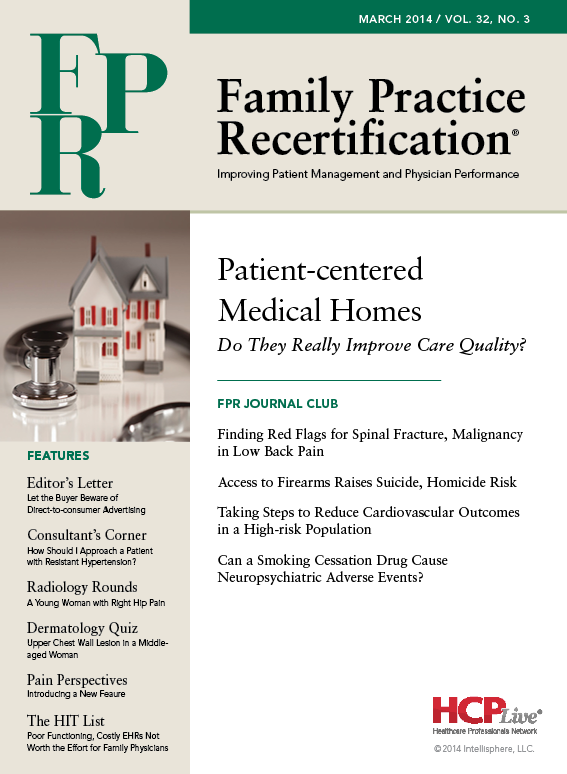Publication
Article
Family Practice Recertification
Finding Red Flags for Spinal Fracture, Malignancy in Low Back Pain
Author(s):
Older age, chronic corticosteroid use, severe trauma, abrasion, or some combination of red flags predict an increased risk of spinal fracture, but a prior history of malignancy is the only useful predictor of spinal malignancy.
Frank J. Domino, MD
Review
Downie A, et al. Red flags to screen for malignancy and fracture in patients with low back pain: systematic review. BMJ. 2013;347:f7095. http://www.bmj.com/content/347/bmj.f7095.
Study Methods
This systematic review evaluated 53 red flag signs and symptoms for spinal fracture and malignancy in adult patients with low back pain. Of the 14 included studies, 8 were set in primary care, 2 in secondary care, and 5 in tertiary care.
Intervention and Control
Standard systematic review protocols were followed using a Cochrane Diagnostic Test Accuracy Working Group method to evaluate for bias.
The authors identified 29 red flags to screen for spinal fracture and 24 to screen for spinal malignancy, with 13 red flags evaluated in more than 1 study. Only 6 studies evaluated the accuracy of combinations of red flags, and a minority of studies provided definitions for each red flag.
Results and Outcomes
The prevalence* of fracture and malignancy varied by study location. In terms of fractures, the primary care papers found median 3.6% prevalence, though the secondary and tertiary care papers found median 6.5% prevalence. Regarding malignancy, the primary care papers reported 0.2% prevalence, 1 secondary care study detected 7% prevalence, and 2 tertiary care studies showed 1.5% and 5.9% prevalence.
The red flags with the highest likelihood for detection of fracture were:
- Age >65 years for men and >75 years for women
- Prolonged use of corticosteroid drugs
- Severe trauma
- Presence of a contusion or abrasion
When multiple red flags were present, the probability of spinal fracture was higher.
The only red flag with an increased likelihood for spinal malignancy was a history of malignancy.
Conclusion
In a statistical evaluation of signs and symptoms in low back pain, older age, chronic corticosteroid use, severe trauma, abrasion, or some combination of red flags predicted an increased risk of spinal fracture, but only a prior history of malignancy predicted an increased risk of spinal malignancy.
*Prevalence is the percentage of a population that has a particular condition. For example, the prevalence of gout in the United States is 4%.
Commentary
Many practice guidelines use red flags to identify patients with low back pain who require further testing to rule out serious causes for their pain. The traditional red flags include trauma; fever; unintentional weight loss; history of malignancy; age <18 or >50 years; pain while at rest or the supine position; history of intravenous drug use or recent serious infection; and urinary incontinence or saddle anesthesia known as cauda equina syndrome (CES). As these have all been identified by observational studies and applications of pathophysiologic estimations. This study helps clarify the clinical signs and symptoms that actually predict a worrisome cause for low back pain.
Older age, history or signs of trauma, and long-term corticosteroid use makes both intuitive sense and a statistically significant correlation for fractures. Missing or delaying in finding a fracture can be catastrophic, but with careful follow-up, it is unlikely. Unfortunately, only a history of malignancy was shown to correlate with an increased risk of malignancy and this lack of association to something as severe and time sensitive as a malignancy leaves clinical practice far too gray.
Despite the lack of strong evidence, one reasonable approach to evaluating patients with new-onset low back pain for red flags includes:
- If the patient has a history of malignancy or appears ill without a history of infectious risk factors, then consider plain X-rays, erythrocyte sedimentation rate (ESR), complete blood count, alkaline phosphatase testing, urinalysis, and prostate-specific antigen (PSA) testing for males.
- If the patient is a young adult whose pain worsens in a supine position, yet improves with exercise, consider plain X-rays or ESR.
- If there is fever, symptoms of CES, or severe or emergent neurologic deficits such as a foot drop, consider magnetic resonance imaging (MRI).
- Do not order routine imaging or blood tests for patients with low back pain for less than 6 weeks in duration who display no red flags.1
Acute low back pain is self-limiting in more than 90% of patients and remains one of the most common presenting complaints in ambulatory medicine. This study guides family physicians on when and how to look further, especially for fractures. Maintaining careful, close follow-up of all patients whose low back pain does not improve after 6 weeks will almost always identify the rare cases where something more serious is present.
References
1. Chou R, et al. Diagnostic imaging for low back pain: advice for high-value health care from the American College of Physicians. Ann Intern Med. 2011. 154(3):181-9. http://annals.org/article.aspx?articleid=746774.
About the Author
Frank J. Domino, MD, is Professor and Pre-Doctoral Education Director for the Department of Family Medicine and Community Health at the University of Massachusetts Medical School in Worcester, MA. Domino is Editor-in-Chief of the 5-Minute Clinical Consult series (Lippincott Williams & Wilkins). Additionally, he is Co-Author and Editor of the Epocrates LAB database, and author and editor to the MedPearls smartphone app. He presents nationally for the American Academy of Family Medicine and serves as the Family Physician Representative to the Harvard Medical School’s Continuing Education Committee.






